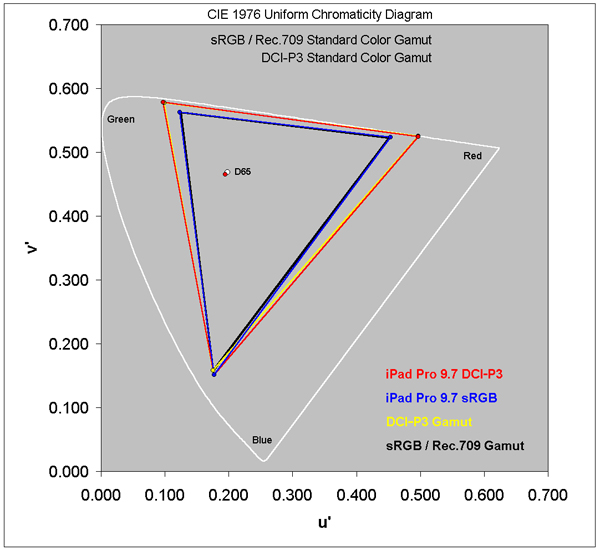Anyone who cares about display quality in their handheld devices has probably come across DisplayMate reviews, and the latest product to be evaluated by Ray Soneira is the new iPad Pro 9.7″. Spoiler: “It is by far the best performing mobile LCD display that we have ever tested.”
Whether you find tablets useful or not, and whatever you think of Apple, it’s hard to criticize the quality of the displays they use in iPads — they’ve been good since the very first XGA generation. The iPad Pro 9.7″ not only is no exception, it’s the cherry on top.
Color accuracy is “visually indistinguishable from perfect,” fully covering not one but two overlapping gamuts: the standard sRGB and the newer, broader DCI-P3 standard for 4K TVs. This is good news for people who, for whatever reason, want to do serious color work on their iPad. I understand some people prefer it over a Surface or even Wacom-type tablet for sketching and painting apps, so this should be a boon for them as well.

This diagram shows the two color gamuts supported by the iPad. Usually the display’s actual triangle is not so perfectly superimposed on the theoretical range — the difficulty of reading this chart is a good indication of the quality of the display.
Screen reflectance — always a pet peeve of mine, with my mirrorlike iPad the chief offender — is hugely improved. Bright ambient light has to be effectively scattered without being allowed to affect the image, and the new iPad apparently does it noticeably better than any tablet or smartphone currently available.
Peak brightness is also 20 percent better than the other available iPads. That’s nice in areas with lots of ambient light, but a side bonus is the ability to run the display partially dimmed most of the time, saving battery life. (Ultimately, however, the power efficiency is the same for this and the iPad Air 2.)
As for the features that adjust white point and color balance in response to ambient light, Soneira is not opposed, but suggests users be able to adjust the effect to their liking. (I’m opposed. A display that changed its tone curve and warmth while I watched would drive me insane. Turning it off would be the very first thing I did.)
You can read the full details, including test setup, response curves and so on, at the DisplayMate article.
